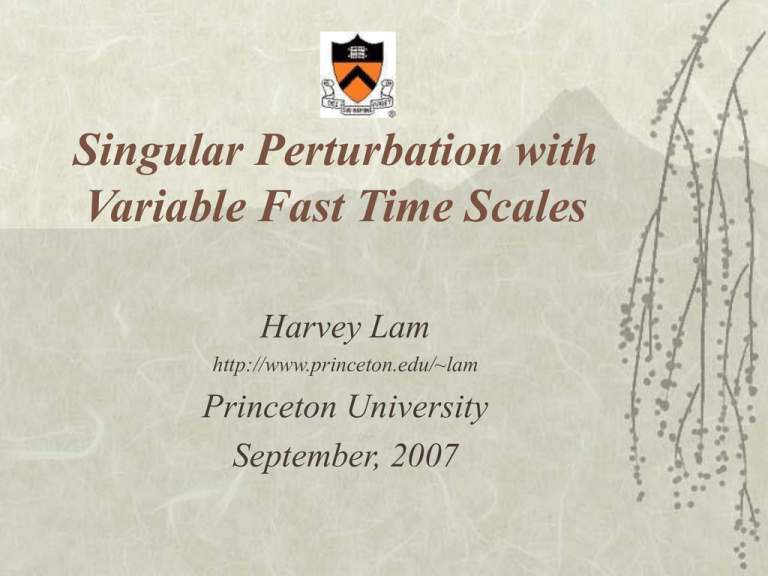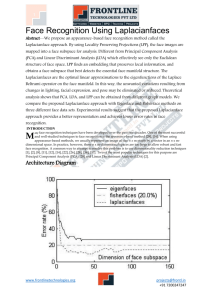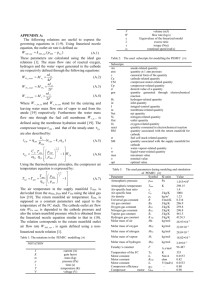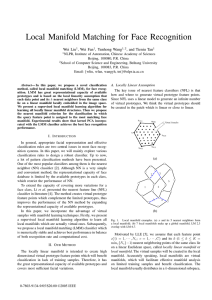Rome - Princeton University
advertisement

Singular Perturbation with Variable Fast Time Scales Harvey Lam http://www.princeton.edu/~lam Princeton University September, 2007 Why do reduced models? To reduce the number of unknowns, To reduce stiffness, To gain insights on the system under investigation. -------Finding a “slow manifold” is not enough. Analytical asymptotics needs a dimensionless epsilon: <<1 Generic problem statement (t=O(1)): dy g(y;) w(y), y(0) y o . dt What happens when g(y;) is singular in the small limit? (note: w(y) and yo has no singular dependence) When g(y;) is uniformly singular in the small limit, it is a classical singular perturbation problem. No problem. Real world problems often have no uniformly small epsilons Real world problems are usually nonlinear and dimensional. Most parameters in real world problems are dimensional. Many interesting real world problems are intractable by pen-and-pencil analysis. All the Rome ODE benchmark problems have non-uniformly small epsilons. What do most people do? (for a N variables problem) Somehow figure out that M of the original N variables are fast. Denote them by r. The rest of the variables are denoted by s. Numerically compute for: r S(s) and call this algebraic relation the Slow Manifold (useful for certain initial conditions). Some details (r is fast, s is slow) Suppose we arrange the variables so that: r y s Then the original ODEs are: dr g r (r, s;) wr (r, s) dt s g s (r, s;) ws (r, s) How useful is any numerical Slow Manifold r=S(s)? The original ODEs are: d r g r (r, s;) wr (r, s) dt s g s (r, s;) ws (r, s) Can we do the following? r S(s), ds g s (S(s),s;) w s (S(s),s). dt Answer: sometimes yes, sometimes no. Even when epsilon is uniformly small. It is yes when the chosen r fast variables accept the QSSA---quasi-steady-stateapproximation. It is no when the r fast variables needs the PE---partial equilibrium approximation. For messy large real world problems, we usually don’t know which is which. What is “all you need”? The leading-order Slow Manifold Projector: Q slow (M) I Q fast (M), M Q fast (M) a m bm , m1 where am and bm are (column and row) CSP-refined fast basis vectors. They are independent of w(y). If the CSP bm refinement “converges”, there is a slow manifold right here. What the CSP-refined basis vectors tell you…. Here are the projectors: Q slow (M) I Q fast (M), M Q fast (M) a m bm , m1 The Slow Manifold after K cycles of 2-step CSP refinement is: f (y;) b m m g(y;) O( ), m 1,..., M. K The Reduced Model After the fast transients die (using Kth-CSP-refined basis vectors): dy Qslow(M) g(y;) w(y) O( K ). dt One may remove any M differential equations here and replace them by the M algebraic equations of state in the previous slide. Number of variables is reduced! The two-step CSP refinement Step one refines the bm vectors. This provides the slow manifold. Step two refines the am vectors. This removes stiffness from reduced model. If the refinement “iterations” for bm does not seem to converge, there is no slow manifold here. The Williams Problem dx x xy, dt dy 1 x ( 1)xy y dt CSP form of the system (no approximation) dY(x) 1 x x d x (1) dx f (2), 1 f dY(x) dt y dx x Y(x) , ( 1)x f (2) dY (x) f (x, y;) Y (x) y , ( 1)x dx (1) f (2) (x) x(1 Y (x)), (x;) . ( 1)x x is non-uniformly small when is small. dY(x) d x x (1) 1 x dx (2) 1 f dY(x) f , dt y dx x Y(x) , ( 1)x (y is QSSA) f (2) dY (x) f (x, y;) Y (x) y , ( 1)x dx (1) f (2) (x) x(1 Y (x)), (x;) . ( 1)x The Lindemann Problem d y 1 z(z y) 1 y z 1 dt 0 CSP form of the problem (exact): y 1 (z y) y 1 d 2 2 y, 1 dt z 1 2 (z;) . z Lindemann is a PE problem! Leading approximation to slow manifold: y z O( ) is completely correct… but completely useless in the original ODEs---even if is uniformly small. The Semenov ODE Problem Originals: d x x 1 f (y ) D (1 x)e , a dt y (1 )y B y f (y) . 1 y / Introduce a new variable: R Da (1 x)e f (y ) . x 1 1 x d B (R R ) BR (1 )y, y 1 dt R 0 0 More on Semenov ODEs x 1 x d R R y B B R (1 )y , dt R 1 0 0 Where plays the role of epsilon: x(1 y / ) 2 (1 )(1 x)y R (x, y) , 2 (1 y / ) B(1 x) (1 y / ) 2 (x, y) . f (y ) 2 Da e (1 y / ) B(1 x) Coming out of a slow manifold It is possible for (x,y) to be small for a while, then become a non-small number later. Solutions with diverse initial conditions would become a tight bunch when they enter into the slow manifold. When these bunched solutions come out of the slow manifold, they may still look bunched. But appearance of bunching is not sufficient to conclude that there is a slow manifold. The Semenov PDE Problem Original PDEs: dc 2c Le 2 2e /T c, dt x dT 2T 2 2e /T c. dt x CSP form: d c 1c dt T When diffusion is absent (or if Le=1), T+c is independent of details of the chemistry term. 2c Le 2 2 x , (T) e( /T 2 ln ) . T x 2 On the non-chemistry term How does the magnitude of the diffusion term depend on the magnitude of ? Answer: if diffusion needs to compete (such as near a boundary), it can and will match whatever the chemistry term has to offer! Whenever this happens, there is no slow manifold (number of unknowns cannot be reduced). The Davis Skodje Problem Original ODEs: dy1 y1, dt dy 2 ( 1)y1 y12 y 2 . 2 dt (1 y1 ) This ODE follows (without approximation): d y1 y1 y 2 y 2 , dt 1 y1 1 y1 which is valid even for arbitrary (y1,y2)! Large and small d y1 y1 y 2 y 2 , dt 1 y1 1 y1 Slow manifold: (large limit) y1 y2 , ( ). 1 y1 Conservation Law: (small limit) y1 y1 (0) y2 y 2 (0) , ( 0). 1 y1 1 y1 (0) Slow manifold versus Conservation Laws Consider: dy a1 f 1 ...a M f M a M 1 f M 1 ... a N f N . dt We get a slow manifold when f1 decays to become small: 1 f (y;) O(). If fN is always small, AND if bN is the gradient of a scalar, then we get an Conservation Law for Approximate that scalar (e.g. an Hamiltonian and …). Concluding Remarks In general, finding a slow manifold is not enough. A slow manifold should be useful for problems other than the one you found it from. (i.e. good for different w(y)’s---such as “missing” reactions, any slow perturbations, diffusions, control forces …) Reduced models should be able to use single precision numerical slow manifolds. Reduced models should tell you some interesting and insightful things about the system. http:www.princeton.edu/~lam







